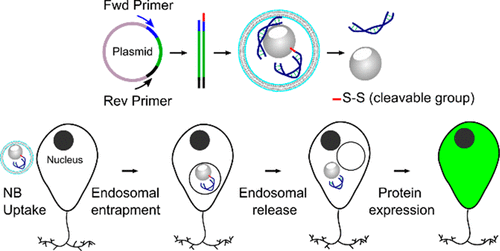当前位置:
X-MOL 学术
›
Bioconjugate Chem.
›
论文详情
Our official English website, www.x-mol.net, welcomes your
feedback! (Note: you will need to create a separate account there.)
Lipid-Encapsulated Silica Nanobowls as an Efficient and Versatile DNA Delivery System
Bioconjugate Chemistry ( IF 4.0 ) Pub Date : 2020-11-24 , DOI: 10.1021/acs.bioconjchem.0c00493 Madhura Som 1 , Ratnesh Lal 2, 3 , Victor Ruiz-Velasco 4
Bioconjugate Chemistry ( IF 4.0 ) Pub Date : 2020-11-24 , DOI: 10.1021/acs.bioconjchem.0c00493 Madhura Som 1 , Ratnesh Lal 2, 3 , Victor Ruiz-Velasco 4
Affiliation

|
Nonmesoporous Janus silica nanobowls (NBs) are unique in that they possess two different nonporous surfaces per particle for loading biological molecules and can thus be designed with multifunctional properties. Although silica NBs have been successfully employed for both targeted therapeutic and diagnostic applications, their ability to deliver DNA has not yet been fully explored. The purpose of this study was to design and develop an in vitro transfection agent that would exploit the distinct characteristics of the silica NB. First, we determined that the NB surface can be linked to either supercoiled cDNA plasmids or vectorless, linear cDNA constructs. Additionally, the linearized cDNA can be functionalized and chemisorbed on NBs to obtain a controlled release. Second, the successful transfection of cells studied was dependent on lipid coating of the NB (LNBs). Although both NBs and LNBs were capable of undergoing endocytosis, NBs appeared to remain within vesicles as shown by transmission electron microscopy (TEM). Third, fluorescence microscopy and Western blotting assays revealed that transfection of four different cell lines and acutely isolated rat sensory neurons with LNBs loaded with either linear or supercoiled cDNA constructs coding for the fluorescent protein, clover and tdTomato, resulted in protein expression. Fourth, two separate opioid receptor–ion channel signaling pathways were functionally reconstituted in HEK cells transfected with LNBs loaded with three separate cDNA constructs. Overall, these results lay the foundation for the use and further development of LNBs as in vitro transfection agents.
中文翻译:

脂质包裹的二氧化硅纳米碗作为一种高效且多功能的DNA传递系统
非介孔Janus二氧化硅纳米碗(NBs)的独特之处在于,每个粒子具有两个不同的无孔表面,可装载生物分子,因此可以设计为具有多功能特性。尽管二氧化硅NBs已成功用于靶向治疗和诊断应用,但其传递DNA的能力尚未得到充分研究。这项研究的目的是设计和开发一种体外转染剂,它将利用二氧化硅NB的独特特性。首先,我们确定NB表面可以与超螺旋cDNA质粒或无载体的线性cDNA构建体连接。此外,线性化的cDNA可以被功能化并化学吸附在NB上以获得控制释放。第二,研究细胞的成功转染取决于NB(LNB)的脂质包被。尽管NB和LNB都能够进行胞吞作用,但如透射电镜(TEM)所示,NB似乎保留在囊泡中。第三,荧光显微镜和Western印迹分析表明,用装载了编码荧光蛋白,三叶草和tdTomato的线性或超螺旋cDNA构建体的LNB转染四种不同的细胞系和急性分离的大鼠感觉神经元,导致蛋白表达。第四,两个单独的阿片样物质受体离子通道信号通路在载有三个单独的cDNA构建体的LNB转染的HEK细胞中进行了功能重建。总体,
更新日期:2020-12-16
中文翻译:

脂质包裹的二氧化硅纳米碗作为一种高效且多功能的DNA传递系统
非介孔Janus二氧化硅纳米碗(NBs)的独特之处在于,每个粒子具有两个不同的无孔表面,可装载生物分子,因此可以设计为具有多功能特性。尽管二氧化硅NBs已成功用于靶向治疗和诊断应用,但其传递DNA的能力尚未得到充分研究。这项研究的目的是设计和开发一种体外转染剂,它将利用二氧化硅NB的独特特性。首先,我们确定NB表面可以与超螺旋cDNA质粒或无载体的线性cDNA构建体连接。此外,线性化的cDNA可以被功能化并化学吸附在NB上以获得控制释放。第二,研究细胞的成功转染取决于NB(LNB)的脂质包被。尽管NB和LNB都能够进行胞吞作用,但如透射电镜(TEM)所示,NB似乎保留在囊泡中。第三,荧光显微镜和Western印迹分析表明,用装载了编码荧光蛋白,三叶草和tdTomato的线性或超螺旋cDNA构建体的LNB转染四种不同的细胞系和急性分离的大鼠感觉神经元,导致蛋白表达。第四,两个单独的阿片样物质受体离子通道信号通路在载有三个单独的cDNA构建体的LNB转染的HEK细胞中进行了功能重建。总体,











































 京公网安备 11010802027423号
京公网安备 11010802027423号